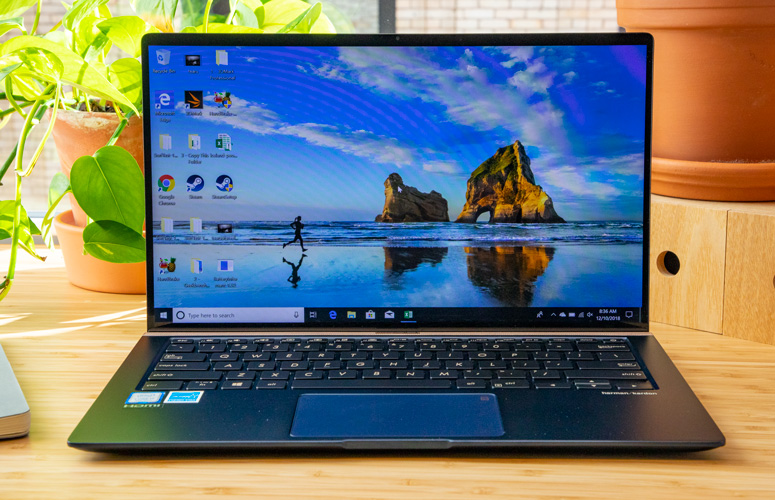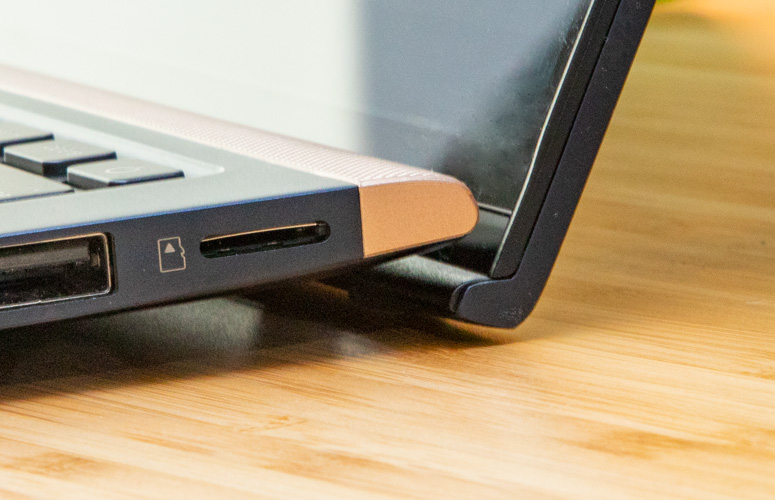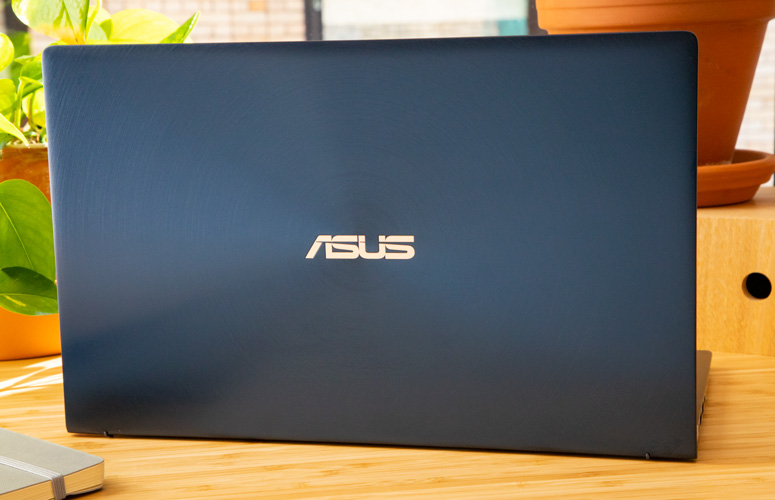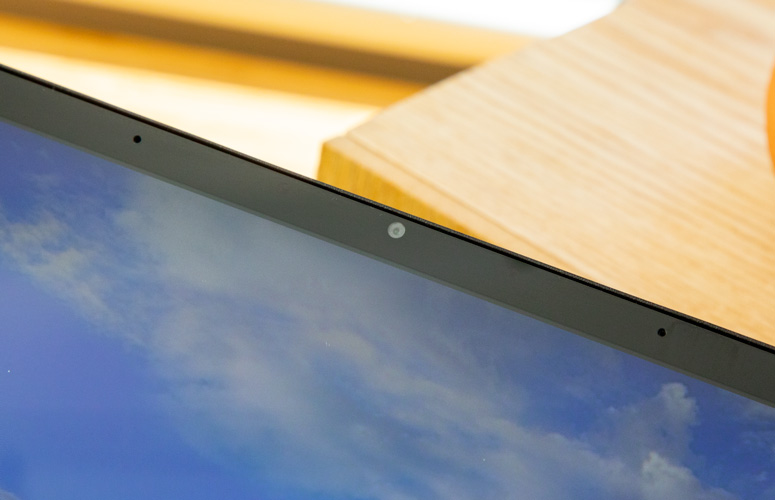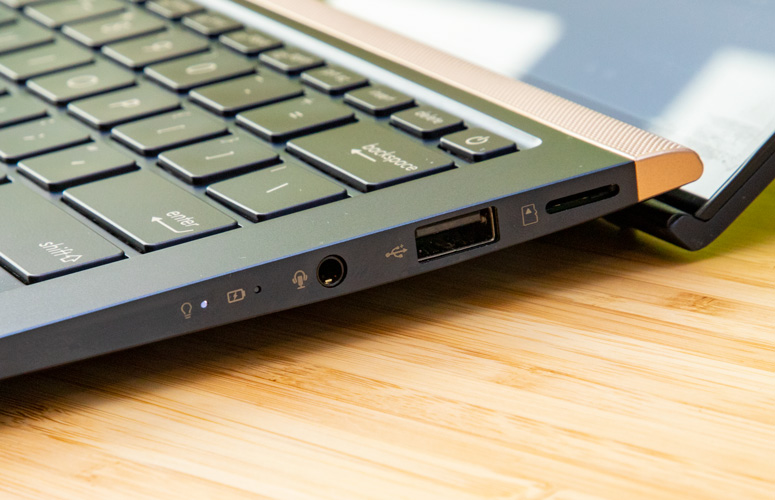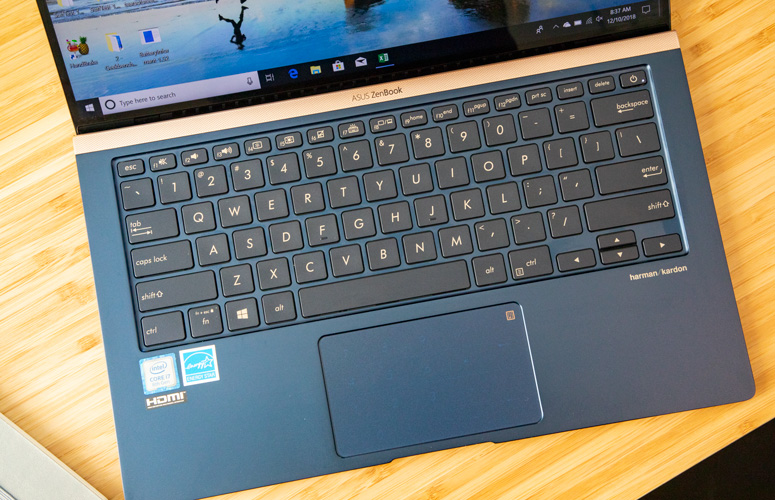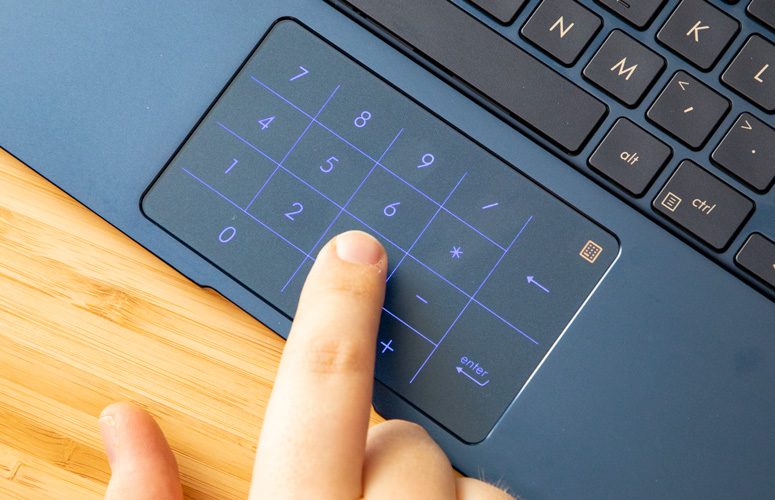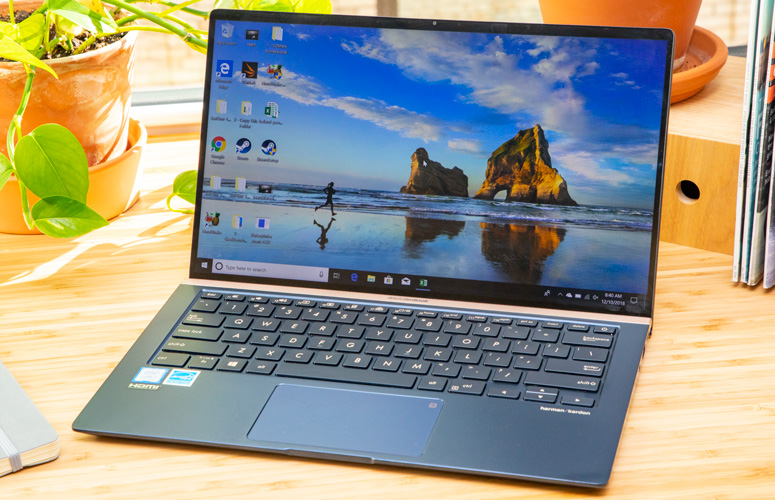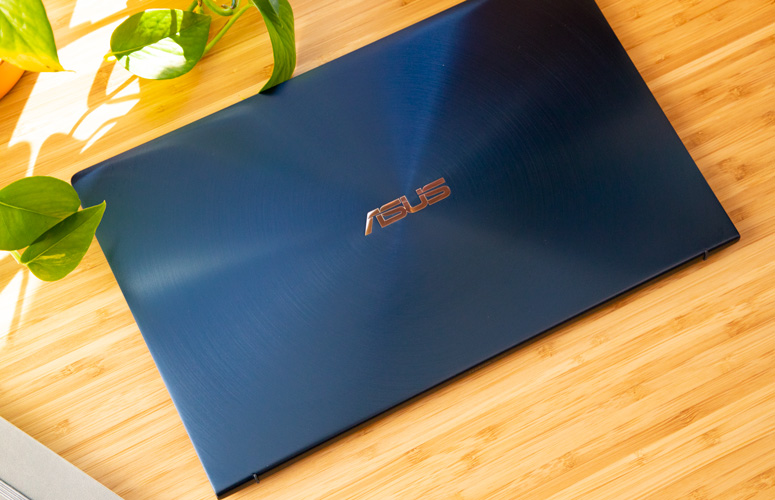Laptop Mag Verdict
The Asus ZenBook 14 is an excellent ultrabook that fits a 14-inch display in a 13-inch chassis.
Pros
- +
Compact and durable design
- +
Luxurious aluminum chassis
- +
Innovative LED numpad
- +
Decent speakers
- +
Competitive price
Cons
- -
Dim display
- -
Finicky touchpad
- -
Poor webcam
- -
No Thunderbolt 3
Why you can trust Laptop Mag
With a remarkably compact chassis and solid performance, the Asus ZenBook 14 is one of the few laptops I've tested that I would buy for myself. Starting at $999 ($1,199 as tested), this laptop puts a 14-inch display on the frame of a traditional 13-inch notebook, and its sexy dark-blue aluminum chassis is tested to military-grade durability. Not to mention, the laptop's touchpad has an intuitive LED-illuminated numpad built in.
Best of all, the ZenBook 14 is surprisingly affordable. For $1,199, you get a Core i7 CPU, 16GB of RAM and a 512GB SSD, enough for us to have no problem calling it one of the best Asus laptops. If the notebook's display weren't so dim and the battery life were a bit longer, the ZenBook 14 would make a serious run for the best overall laptop. Although it falls just short of that mark, the ZenBook 14 is a great choice for students and professionals alike.
Asus ZenBook 14 UX433 price and configuration options
Priced at a competitive $1,199, our review unit of the ZenBook 14 comes with an Intel Core i7-8565U CPU, 16GB of RAM, a 512GB SSD and integrated UHD 620 graphics. The base model, available only in silver, costs $999 and comes equipped with a Core i5-8265U CPU, 8GB of RAM and a 256GB SSD. A third model will feature an Nvidia GeForce MX150 GPU and the option for up to a 1TB SSD. Pricing is still unknown for that upcoming gamer-friendly model.
Asus ZenBook 14 UX433 design
From the laptop's shimmering, dark-blue paint job to its premium materials, the ZenBook 14 is one of the sleekest devices I've tested, but it's the laptop's impossibly small size that really had me floored.
Asus reduced the ZenBook 14's footprint to about the size of a standard A4 sheet of paper by trimming down the display bezels to 2.9 millimeters. The result is a screen-to-body ratio of 92 percent, which is even more impressive than the standard-setting XPS 13 (80.7 percent).
The ZenBook 14 adopts the clever ErgoLift hinge we've seen on other ZenBook laptops released this year. When you open the laptop's lid, the back of the ZenBook 14's chassis lifts off the ground a few millimeters, which angles the keyboard downward 3 degrees. The raised keyboard is designed to provide a more comfortable typing experience, optimize cooling and improve audio quality. In general, I found each of these claims to be true, although the benefits are minor.
The ZenBook 14 features Asus' signature concentric-circle design etched into the lid, surrounding a centered, golden brand emblem. Running the width of the laptop where the deck meets the display is a stippled gold bar with a centered Asus ZenBook logo. The rest of the deck is colored in the same beautiful Royal Blue as the lid, while the keyboard sports a darker indigo tone. Gold keyboard font and Harmon/Kardon branding tie together this luxurious color scheme (Asus also offers a less exciting silver-and-gold variant).
Sign up to receive The Snapshot, a free special dispatch from Laptop Mag, in your inbox.
The ZenBook 14 is one of the sleekest devices I've tested, but it's the laptop's impossibly small size that really had me floored.
There is plenty of brawn to go along with the ZenBook 14's beauty. The sturdy aluminum laptop is tested to MIL-STD 810G, or military-grade durability. We typically find this certification only on pricey business-grade laptops, so I was pleasantly surprised to find a consumer device that is just as rugged. What it means for your average shopper is that the ZenBook 14 can withstand extreme temperatures, humidity and altitudes, as well as drops and vibration.
The ZenBook 14 lacks a fingerprint sensor, but an IR camera (positioned on the narrow hinge above the display) allows for fast and secure Windows Hello login.
At 12.7 x 7.8 x 0.6 inches and 2.6 pounds, the ZenBook 14 is smaller and lighter than many 13.3-inch ultrabooks, not to mention the majority of 14-inch machines. The MSI PS42 8RB Prestige (12.7 x 8.7 x 0.6 inches, 2.6 pounds) weighs about as much as the ZenBook 14, but that laptop isn't as compact. The heftier Huawei MateBook X Pro (12 x 8.5 x 0.6 inches, 2.9 pounds) is narrower but longer than the ZenBook 14, and even the featherweight LG Gram has a larger overall footprint than the Asus (12.7 x 8.3 x 0.6 inches, 2.2 pounds).
Asus ZenBook 14 UX433 ports
The ZenBook 14 has a wide variety of ports for all of your peripherals and accessories.
The left side houses a USB-C port, a USB 3.1 input and an HDMI connector. To the right, you will find a microSD card slot for uploading photos next to a USB 2.0 port and a combination headphone/mic jack. Small LEDs indicate battery level and power mode.
I wish Asus had replaced the ZenBook 14's slow-charging DC-in connector with a Thunderbolt 3 port. The missing Thunderbolt 3 port is a disappointing omission on such an expensive laptop, and it means that the ZenBook 14 can't connect to a graphics amp and certain docking stations.
Asus ZenBook 14 UX433 display
The ZenBook 14's razor-thin bezels make for an immersive viewing experience, but the laptop's vivid 14-inch, 1080p display doesn't get very bright.
When I watched a trailer for the upcoming Transformers spin-off, Bumblebee, I could make out dozens of tools hanging on the back wall of Charlie Watson's (Hailee Steinfeld) garage, from a large mallet to her vast collection of screwdrivers. When Bumblebee awakens from its slumber, the charming robot's entrancing blue eyes burst with color, and its armored shell looked a deep, rich yellow.
The ZenBook 14's razor-thin bezels make for an immersive viewing experience, but the laptop's vivid 14-inch, 1080p display doesn't get very bright.
The ZenBook 14's display reproduced 121 percent of the sRGB color gamut, making it more vivid than the panel on the PS42 8RB (116 percent) and the average premium laptop (117 percent). However, the displays on the MateBook X Pro (124 percent) and Gram (128 percent) are even more colorful.
Sadly, outdoor visibility on this glossy, non-touch panel is poor because of its dim backlighting. While I noticed a slightly pink cast to the display's white balance when I visited some of my favorite websites, the images I viewed exhibited accurate colors.
MORE: Highest Resolution Screens
The notebook just barely breached the 200 nit mark, at 217 nits. To put that into perspective, we typically look for at least 300 of nits of brightness on a laptop in this class, which is right around the category average (317 nits). The MateBook X Pro's (458 nits) display is more than twice as bright as the ZenBook's, and the Gram (307 nits) is just short of 100 nits brighter. Even the dim display on the PS42 8RB Prestige (243 nits) is brighter than the ZenBook 14's screen.
Asus ZenBook 14 UX433 keyboard and touchpad
In our estimation, thin laptops don't always suffer from uncomfortable keyboards. The ZenBook 14 proves that by offering a generally great typing experience, albeit, one that won't suit every user.
While the laptop's backlit keys are relatively shallow at 1.1 millimeters, they exhibit nice tactile feedback. Additionally, the 64 grams of actuation force ensured my fingers never became fatigued when I used the island-style keyboard to type this review.
However, I did run into an annoyance that could complicate the typing experience for some users. Because the deck is so cramped, my thumb joint hit the deck between the touchpad and keyboard when I pressed the spacebar. This quirk isn't exactly a deal-breaker since a minor adjustment to my typing style solved the discomfort.
I typed at 101 words per minute with an accuracy of 92 percent on the ZenBook 14. Both results are below my averages of 109 wpm with an error rate of 5 percent.
I have mixed feelings about the ZenBook 14's 4.1 x 2.4-inch touchpad. On one hand, there were occasions when my cursor slowed down while I was browsing the web, especially under a heavy workload. Also, the tap-to-click function isn't sensitive enough, and I found myself resorting to the left-click button. The touchpad missed presses even after I adjusted the touchpad taps-to-click sensitivity to "Most sensitive."
On the other hand, the touchpad's integrated LED-illuminated numpad, which can be activated by pressing a small icon in the corner, is super convenient. When you press the button, a grid lights up on top of the surface, allowing you to type numbers and use mathematical functions. The feature worked well in my testing, although I hope Asus adds some capacitive feedback in future editions.
Asus ZenBook 14 UX433 audio
The rear-firing stereo speakers on the ZenBook 14 had me tapping my foot along to Devon Gilfillian's funky groove "High." The soul singer's smooth vocals pierced through the catchy drum rhythm, which thumped along with a good amount of weight. However, the overall sound signature of the Harman/Kardon-tuned speakers is a bit bright, as the midrange lacked bass and the emphasized treble tones sounded slightly veiled.
MORE: Best Laptops for Music Production
The ZenBook 14 easily filled my medium-size room with undistorted audio when I cranked up Disclosure's hit "You & Me." Each instrument in this complex electronic track was clearly defined, and the bass hit with a surprising amount of power. But again, the song lacked richness in the mid-to-upper frequencies.
Asus ZenBook 14 UX433 performance
With an Intel Core i7-8565U CPU and 16GB of RAM, the ZenBook 14 did a valiant job during my rigorous real-world testing, although I ran into a strange problem with the touchpad. The ZenBook 14 swiftly loaded 20 Google Chrome tabs and played four 1080p videos without lag, but my cursor started to slow down when I tried switching tabs. Refreshing my browser fixed the issue, and I didn't run into further problems when I replicated the test.
The ZenBook 14 was a mixed bag in our benchmark tests. The laptop scored a solid 11,804 on the Geekbench 4.1 overall performance test, topping the Gram (Core i7-8550U, 11,138) and PS42 8RB (Core i7-8550U, 9,766). The MateBook X Pro (Core i7-8550U, 13,769) achieved an even higher result than the ZenBook 14, which fell just short of the premium laptop category average (12,836).
The ZenBook 14 is one of the few laptops I've reviewed that I would consider buying for myself.
Asus didn't skimp on the ZenBook 14's hard drive. The 512GB NVMe SSD duplicated 4.97GB of data in 10 seconds for a rate of 508 megabytes per second. The competition -- the Gram (512GB M.2 SATA SSD, 169.6 MBps), PS42 8RB Prestige (512GB M.2 SATA SSD, 164 Mbps) and MateBook X Pro (512GB NVMe PCIe SSD, 282.7 MBps) -- lagged far behind on our File Transfer Test. The premium laptop average (509.1 MBps) is about as fast as the ZenBook.
Matching 65,000 names with their corresponding addresses in Excel was no issue for the ZenBook 14, which required 1 minutes and 11 seconds to complete the task. That is faster than the Gram (1:19), the PS42 8RB (1:38), the MateBook X Pro (1:49) and the category average (1:39).
The ZenBook 14 needed 24 minutes and 46 seconds to convert a 4K video into 1080p resolution using the HandBrake app. That's longer than what the Gram (22:55), the PS42 8RB (20:00) and the premium category average (21:51) required. The MateBook X Pro (27:18) was several minutes slower than the ZenBook 14.
Asus ZenBook 14 UX433 graphics
With integrated UHD 620 graphics, our review unit of the ZenBook 14 isn't meant for gamers. However, if you play casual games or don't mind low graphics settings, then you should opt for the upcoming GeForce MX150 model.
Our ZenBook 14 scored a lowly 87,446 on the 3DMark Ice Storm Unlimited graphics test. That is far below the GeForce MX150-equipped PS42 8RB (125,326) and MateBook X Pro (116,359). For what it's worth, the Acer did a better job than the Gram (67,989), which has the same UHD 620 GPU.
MORE: Best Graphics Performance
The racing game Dirt 3 played at 45 frames per second on the ZenBook 14, which isn't a particularly good result despite topping our 30 fps playability threshold. The MateBook X Pro (117 fps) and the PS42 8RB (132 fps) predictably provide a much smoother gaming experience. The Gram (50 fps) and premium laptop average (70 fps) also did a better job.
Asus ZenBook 14 UX433 battery life
The ZenBook 14 lasted 8 hours and 37 minutes on the Laptop Mag Battery Test, which involves continuous web surfing over Wi-Fi at 150 nits of brightness. That's a respectable result, but we're starting to see more ultrabooks, like the Gram (10:46) and the MateBook X Pro (9:55), get closer to 10 hours of endurance. The premium laptop average (8:22) is still below the ZenBook 14's runtime, and the PS42 8RB (6:22) powered down before its competitors.
Asus ZenBook 14 UX433 webcam
I have to give props to Asus for positioning the webcam on the ZenBook's thin top bezel. Still, the quality of the 720p camera is pretty lackluster. A selfie I took was so grainy that my facial features looked indistinct. The camera did a good enough job accurately capturing my navy-blue backpack, but the bright lights in our office blew out the background.
Asus ZenBook 14 UX433 heat
The ZenBook 14's elevated deck did a decent job keeping the chassis cool, but a few areas still warmed to uncomfortable temperatures. The touchpad remained at 87.5 degrees Fahrenheit and the center of the keyboard stayed just below our 95-degree comfort threshold, at 94.5 degrees. However, the bottom of the ZenBook 14 didn't fare as well, hitting 99.5 degrees and maxing out at 100 degrees near the hinge.
Asus ZenBook 14 UX433 software and warranty
Asus used a light touch when preinstalling software on the ZenBook 14. The company left out all but its cloud storage service, Hello, from the main Asus folder. Other additions include MyAsus, which monitors updates and offers member promotions, and IcePower AudioWizard, a program for choosing between preset audio modes. There is also a program for changing the F-keys from hotkeys to traditional function keys.
Candy Crush Saga, LinkedIn, Netflix and other Windows 10 Home mainstays are all here, courtesy of Microsoft. One interesting inclusion on the ZenBook 14 that I haven't come across before is the Fitbit Coach app.
The ZenBook 14 ships with a one-year warranty. See how Asus fared on our Tech Support Showdown and Best and Worst Brands ranking.
Bottom line
The ZenBook 14 is one of the better ultraportables you can buy, but it's not quite the best.The main attraction is the laptop's compact chassis, which fits a 14-inch display in what is essentially the footprint of a traditional 13-inch laptop. And with a gorgeous military-tested dark-blue aluminum finish, the ZenBook 14 combines that convenience with durability and beauty.
Additionally, the portable ultrabook has a good keyboard, solid speakers and respectable battery life. I'm also a huge fan of the integrated numpad, a feature I hope will be adopted by more laptops. The $1,199 ZenBook 14 gets you all of these features while undercutting the competition. Unfortunately, the laptop's dim display and fiddly touchpad open the door to other capable competitors, like the Huawei MateBook X Pro.
Still, the ZenBook 14 easily earns our recommendation for anyone who wants to purchase a portable, premium laptop without breaking the bank.
Asus ZenBook 14 UX433 Specs
| Bluetooth | Bluetooth 5.0 |
| Brand | ASUS |
| CPU | Intel Core i7-8565U |
| Card Slots | microSD |
| Company Website | https://www.asus.com/us/ |
| Display Size | 14 |
| Graphics Card | Intel UHD Graphics 620 |
| Hard Drive Size | 512GB |
| Hard Drive Type | PCIe NVMe SSD |
| Highest Available Resolution | 1920 x 1080 |
| Native Resolution | 1920x1080 |
| Operating System | Windows 10 Home |
| Ports (excluding USB) | Combo Headphone/Mic Jack, HDMI, MicroSDXC card reader, USB 2.0, USB 3.1 with Type-C, USB 3.1 |
| RAM | 16GB |
| RAM Upgradable to | 16GB |
| Size | 12.7 x 7.8 x 0.6 inches |
| Touchpad Size | 4.1 x 2.4 inches |
| USB Ports | 3 |
| Warranty/Support | 1-year warranty. |
| Weight | 2.6 pounds |
| Wi-Fi | 802.11ac |
Phillip Tracy is the assistant managing editor at Laptop Mag where he reviews laptops, phones and other gadgets while covering the latest industry news. After graduating with a journalism degree from the University of Texas at Austin, Phillip became a tech reporter at the Daily Dot. There, he wrote reviews for a range of gadgets and covered everything from social media trends to cybersecurity. Prior to that, he wrote for RCR Wireless News covering 5G and IoT. When he's not tinkering with devices, you can find Phillip playing video games, reading, traveling or watching soccer.
